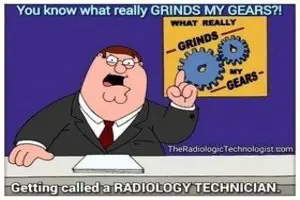I have been working in radiology for over fifteen years. This is the most misunderstood concept that I see on a regular basis. People outside the field of radiology confuse the difference between a radiologic technologist and radiology technician.
Here’s the Difference Between a Radiologic Technologist and Radiology Technician:
- A technician trains to work on radiology equipment. Also called Clinical Engineer, Field Service Engineer or Biomedical Engineer.
- A technologist trains in techniques used to perform diagnostic examinations using radiology equipment and the bioeffects it can cause.

I was at an AHRA conference two years ago. The keynote speaker was telling a joke to the audience.
Someone from the radiologic technologist background was expressing to her a high level of annoyance regarding some topic they were discussing.
The speaker then said to the crowd “You would have thought I called him a Technician or something!”
This earned roaring applause from the group.
Is it all the schooling we go through? Is it the utter disregard for understanding root words?
Further, I really don’t know but the meme showed above, as well as the keynote speakers comment, expresses how most technologists feel in this situation.
And the people who ARE “radiology technicians” are NEVER called those words.
They are known as Field Service Engineers (FSEs), Clinical Engineers (CEs) or Biomedical Engineers (BioMed.) They usually work on more than radiology equipment as well.
Their wheelhouse contains working on patient beds, IV pumps, monitors, wheelchairs and just about anything else mechanical in nature.
You can work in BioMed and assign to radiology equipment only… but you still aren’t a radiology technician. Source: Alan in BioMed.
School Requirement for Radiologic Technologist and Radiology Technician
- Radiologic technologists graduate from a two-year accredited radiography program.
- Radiology Technicians get on-the-job training
Radiologic Technologists require to attend a two-year accredited program. ACCREDITED.
That means not just any street corner technical institute. JRCERT is an organized, official body who makes sure member programs are up to snuff on their requirements.
If you don’t conform to the rigorous standards… you are shuttered. That is a good thing, mind you.
I was living in the Phoenix market a dozen years ago when schools of radiography were popping up everywhere.
At one point I think we had seven or eight: Gateway Community College, PIMA Medical Institute, Central Arizona College, Brymington, Apollo College, Sanford Brown, Carrington… that’s all I can remember at this point.
Too many, even for a big city like Phoenix.
That was bad news for the job market. Serious oversaturation of the market occurred and many technologists could not find jobs.
If graduates can’t find jobs, laws of supply and demand kick in and the schools began to shut down one by one.
If you come across a radiologic technologist complaining of not being able to find a job… most likely they are in the middle of one of these scenarios.
The best option is to move to a better market. Or PRN (part-time work) themselves to several locations.
They can even take travel assignments until something local opens up. There are several opportunities for employment in this field.
Perhaps they didn’t do so well in their clinical rotations and the hospitals have determined this tech isn’t employee material?
Remember, clinical rotations are one giant job interview.

Most accredited programs also require certain classes to complete before applying to the program.
So if you attended a public community college, most likely you completed two years of pre-requisites AND two years of radiography school.
Many schools offer a bachelor’s degree in radiology as a result of the four years of schooling.
I went one step further and earned a master’s degree in radiologic sciences from Weber State.
On the contrary, radiology technicians might attend some school for training but many trains on-the-job.
At the hospitals where I have worked, they hire a radiology technician and fly them to the manufacturer’s on-site training facility for a week, maybe two.
Then they come back and train side-by-side in the hospital. When I negotiate equipment purchases in radiology, I always include some education credits so that my BioMed department can send someone from their team for training.
Medical Licensure need for Radiologic Technologists but not for Technicians
Radiologic technologists must be licensed by the ARRT (American Registry of Radiologic Technologists.)
Currently, all but five states in the USA require a radiology license to perform exams when radiation is involved.
This ensures that the radiographer has been through a rigorous, accredited program and understands the bioeffects and dangers of giving radiation to a patient.
To say these tests are hard is an understatement. Several hours long with 220+ questions, in a seemingly airtight chamber devoid of any sound (a nod to Pearson Vue.) Not everyone passes.
But the accredited programs cannot afford to have less than optimal pass rates or they will get the old skunk-eye from JRCERT... the accrediting body that licenses the radiography schools.
This is why the schools do everything they can to help a student pass.
I currently live in Idaho, which is one of the last states that does NOT require licensure.
I can tell you for a fact that all of the hospitals have taken it upon themselves to require licensure even though it is not a state requirement.
It is THAT obvious to everyone in healthcare that untrained laymen should not be performing exams that require radiation so they have instituted the requirement themselves.
For radiology technicians, no medical licensure is currently required. Source: Mike in my CE department.
The Pay and Opportunity for Radiologic Technologist and Radiology Technician
Radiology Technicians aka Clinical Engineers make about $25.62 per hour according to this site. While Radiologic Technologists earn $27.29 per hour stated here.
You could ask yourself, “Self, why go through all the school if there is such little difference in pay?”
The answer find in all the promotional opportunities that lay ahead for the radiologic technologist.
Once licensed in Radiography, this healthcare worker can proceed to train in many advanced imaging technologies such as:
- Computed Tomography ($27.82/hr),
- MRI ($30.18/hr),
- Ultrasound ($30.04/hr) or
- Nuclear Medicine ($31.34/hr).
- Interventional Radiology ($29.16/hr).
Each one offers more pay, leading upwards of $45 per hour depending on location and time on the job.
Each one of these advanced “modalities” is within reach of hardworking radiologic technologists.
I have personally learned radiography, computed tomography, sonography (ultrasound) and MRI. CT and MRI were learned through on-the-job training.
For ultrasound, I went back to school for two more years but was able to do it while working full time in radiography.
Was it easy?
Heck no. But just like everything else in life… where there’s a will, there’s a way.
Radiology technicians can promote up a career ladder if their organization has one in place.
But there is no equal pathway to what the radiologic technologist has available.
Either one can promote into management… if you want to call that a promotion (wink, wink.)
Patient Contact and Physical Danger for Technologists and Technicians
Radiologic technologists work tirelessly with patients to obtain the most diagnostic image possible.
These can be severely injured trauma patients in the emergency room or “walkie talkies” in an outpatient clinic setting.
Every exam completed by a technologist requires technical skills mixed with human empathy.
It is not uncommon for technologists to console and tend to the emotional needs of a patient.
In fact, patients receive surveys after their visit and are asked questions related to how they were treated by the technologists.
There are no questions related to technicians and technicians rarely have patient contact.
These one-on-one interactions sometimes come with potential physical danger to the technologists.
An ER patient inebriated or on drugs won’t think twice about taking a swing at a technologist while trying to position the patient for an exam.
Moreover, there are also several opportunities to come in direct contact with bodily fluids, airborne pathogens, and other germs when working with patients.
Technicians work only with the equipment and usually in a workshop setting. There’s zero chance of getting kicked by an irate patient or inhaling airborne droplets of tuberculosis being coughed about the room by an unknowing sickly patient.
I’ll take a hammer to the thumb any day over Hepatitis C from a needlestick.
In Reality, They Aren’t Even Radiology Technicians
The funny thing isn’t that we, as technologists, get called technicians all the time….cause we do.
The funny thing is, that even the “technicians” don’t get called technicians. They are called “biomedical engineers” or “clinical engineers.”
Some are called “field service engineers…but none are called technicians.
Moreover, At this point, we just need to let it go. When I’m a technician, I revert back to the old phrase…” just don’t call me late for dinner.” It’s not that big of a deal anymore.
So, I hope these explanations help clear up the difference between radiology technicians and technologists.
If you are interested in the field of radiology at any level, I welcome your questions. You can email me any time: [email protected] and I’ll be happy to talk with you.
- History and Use of a Radiologic Technique Chart
- What is a Radiation Safety Officer and How Do I Become an RSO?
- To Shield or Not to Shield – That is the Question!
- What is a Registered Radiology Assistant and How Do I Become an RRA?
- How to Study for ARRT Board Exam Registry – Proven Scientific Study Methods


